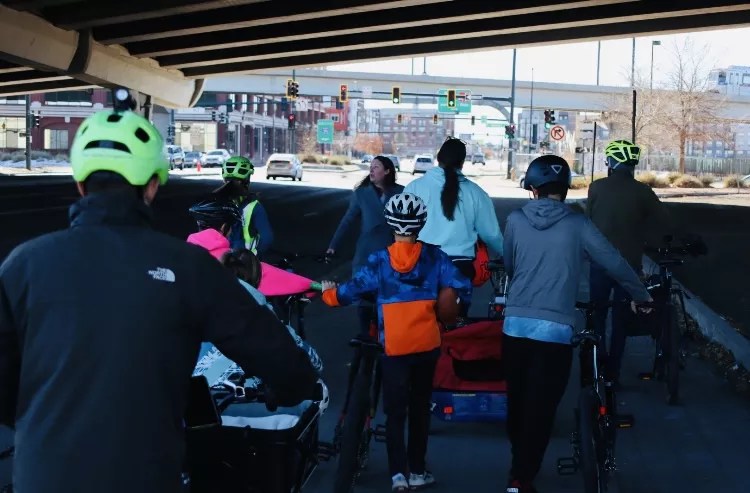
Tafoya for Denver

Audio By Carbonatix
Denver, like the rest of the world, faces a pivotal moment. Will we continue business as usual and hurtle headlong into climate chaos? Or will we learn from past policy mistakes, and take this opportunity to create safe, healthy, green communities?
The science is clear: Climate change is impacting Denver. We suffer drought, we breathe polluted air, and we struggle to pay ever-rising energy prices. Our leaders acknowledge the problems of car dependency, writing plans to improve public transportation and accessibility for walkers and bikers. But when the rubber meets the road, we continue to prioritize cars over people.
Two weeks ago, I had the opportunity to tour the South Broadway & I-25 Improvement Projects area, located at the I-25 intersection with Lincoln and Broadway. In 2008, this project was initiated to connect surrounding neighborhoods to the Broadway 1-25 light rail station. Theoretically, it could be a huge boon for the area when combined with our Bus Rapid Transit Network, the Gates district and Broadway Station Redevelopment. Planning documents boast the creation of beautiful parks and plazas surrounded by a thriving business district and housing.
While we can all get behind this vision, the existing project plan fails to take us to that destination. When you get offline and actually walk this area, you recognize that the current conditions and the planned project are dangerous by design. It’s an obstacle course with multiple high-speed interstate ramps, nineteen lanes of high-injury network roads and an indirect route to transit, all within a third of a mile. Imagine this experience for youth, elderly and those with accessibility needs. That’s why local community organizations, including the Lincoln Broadway Corridor Registered Neighborhood Organization, West Washington Park Neighborhood Association and Baker Historic Neighborhood Association oppose the current proposal. I completely agree with their assessment. The current project prioritizes high-speed interstate automobile movement over community access to the light rail, parks and mixed-use development. The neighborhoods east of the Broadway I-25 light rail station are completely cut off from this development. Even more disturbing, the project proposes demolishing existing homes to expand highway access for drivers outside Denver to zip through and pollute these neighborhoods.
One of the most common criticisms I continue to hear from Denverites is that we are always planning for a better future for new residents or commuters, while leaving existing neighborhoods behind. This project is unfortunately a perfect example of this problem. It’s great to have parks and walkable mixed-use amenities, but what’s the point if existing neighborhoods can’t access them? What’s the point of building a neighborhood if your neighbors have been pushed out to make room for commuter cars?
Moreover, millions of dollars for this project come from various federal, state and local sources (including the DRCOG TIP funds) specifically designated for multi-modal projects like elevated bike lanes and protected crosswalks. The project also actively goes against its own goals listed in the Environmental Assessment, as well as Denver’s citywide plans to reduce emissions and increase safety in transportation.
But this project is not doomed.
Thanks to the work of those community organizers, we have recommendations to improve the project and achieve this vision of a clean, green Denver – without sacrificing communities to do it. The neighborhood organizations’ proposed improvements increase safety while prioritizing our climate goals. These recommendations include traffic-calming measures through the neighborhood, real protection for cyclists and pedestrians utilizing grade-separated infrastructure and barriers, inclusion of the Bus Rapid Transit planning, and improved green space.
Neighbors have joined together to tell the city exactly what good development looks like, and it’s time for the city to listen. We need to prioritize safety for our Denver communities over moving commuters as quickly as possible across the city. We built the regional light rail system through regional cooperation. Let’s continue to work together to move people across our region in a more climate-friendly way, which prioritizes the input of local communities impacted by these infrastructure projects.
To the Denver Regional Council of Governments, Denver Department of Transportation and Infrastructure, Colorado Department of Transportation and the Federal Highway Administration: Consider this an open letter to a better future. A future with fewer pedestrian fatalities and cleaner air, where you can safely walk, bike and bus to a vibrant local economy. We have the opportunity in this moment to put our values into action instead of hanging on to projects that don’t serve the future we have collectively envisioned.
Ean Thomas Tafoya is a candidate for mayor of Denver. Reach him at @EanThomasTafoya.
Westword.com frequently publishes commentaries and essays on matters of interest to the community; the opinions are those of the authors, not Westword. Have one you’d like to submit? Send it to editorial@westword.com, where you can also comment on this piece.